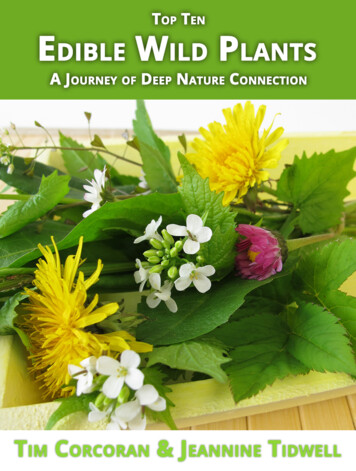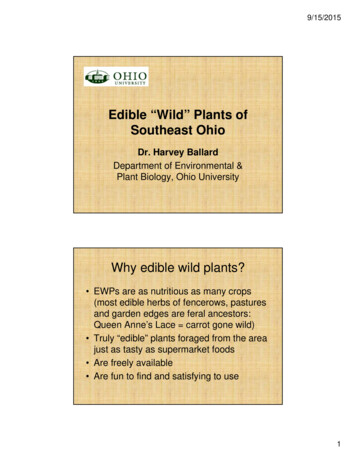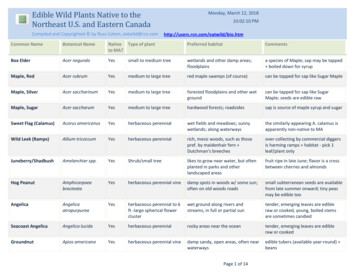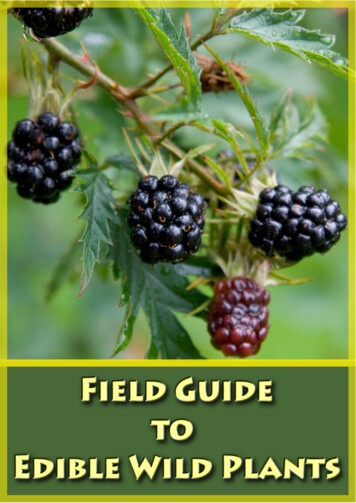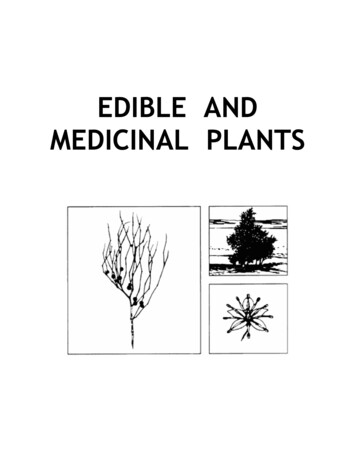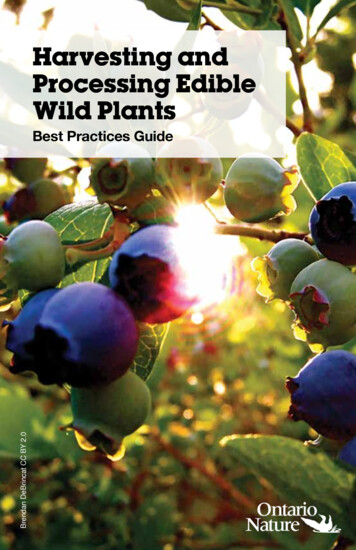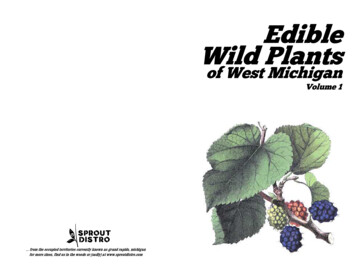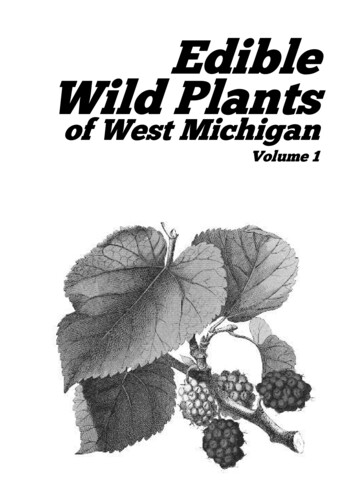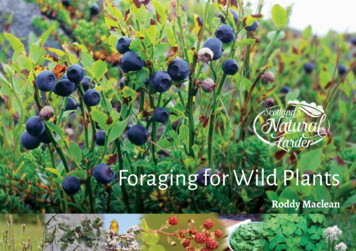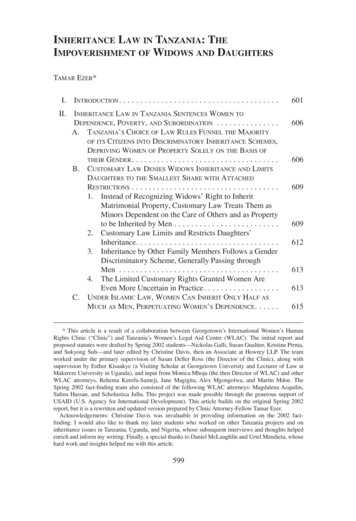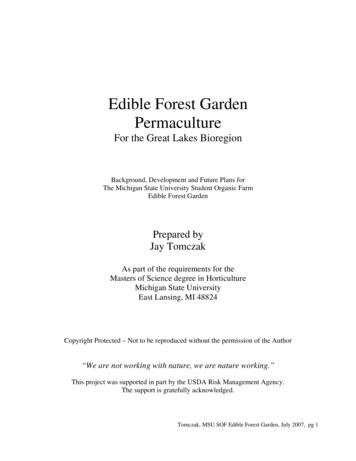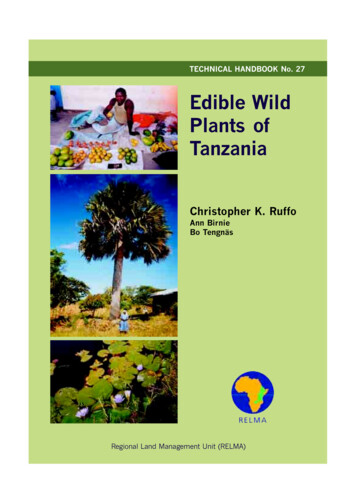
Transcription
TECHNICAL HANDBOOK No. 27Edible WildPlants ofTanzaniaChristopher K. RuffoAnn BirnieBo TengnäsRegional Land Management Unit (RELMA)
RELMA Technical Handbook (TH) seriesTree nursery manual for EritreaChris Palzer. 2002. TH No. 26. ISBN 9966-896-60-0ULAMP extension approach: a guide for field extension agentsAnthony Nyakuni, Gedion Shone and Arne Eriksson. 2001. TH No. 25. ISBN 9966-896-57-0Drip Irrigation: options for smallholder farmers in eastern and southern AfricaIsaya V. Sijali. 2001. TH No. 24. ISBN 9966-896-77-5Water from sand rivers: a manual on site survey, design, construction, and maintenance of seventypes of water structures in riverbedsErik Nissen-Petersen. 2000. TH No. 23. ISBN 9966-896-53-8Rainwater harvesting for natural resources management: a planning guide for TanzaniaNuhu Hatibu and Henry F. Mahoo (eds.). 2000. TH No. 22. ISBN 9966-896-52-XAgroforestry handbook for the banana-coffee zone of Uganda: farmers’ practices and experiencesI. Oluka-Akileng, J. Francis Esegu, Alice Kaudia and Alex Lwakuba. 2000. TH No. 21. ISBN 9966-896-51-1Land resources management: a guide for extension workers in UgandaCharles Rusoke, Anthony Nyakuni, Sandra Mwebaze, John Okorio, Frank Akena and Gathiru Kimaru. 2000.TH No. 20. ISBN 9966-896-44-9Wild food plants and mushrooms of UgandaAnthony B. Katende, Paul Ssegawa, Ann Birnie, Christine Holding and Bo Tengnäs. 1999. TH No. 19.ISBN 9966-896-40-6Banana production in Uganda: an essential food and cash cropAloysius Karugaba and Gathiru Kimaru. 1999. TH No. 18. ISBN 9966-896-39-2Agroforestry extension manual for eastern ZambiaSamuel Simute, C.L. Phiri and Bo Tengnäs. 1998. TH No. 17. ISBN 9966-896-36-8Water harvesting: an illustrative manual for development of microcatchment techniques for cropproduction in dry areasMwangi T. Hai. 1998. TH No. 16. ISBN 9966-896-33-3Integrated soil fertility management on small-scale farms in Eastern Province of ZambiaThomas Raussen (ed.). 1997. TH No. 15. ISBN 9966-896-32-5Agroforestry manual for extension workers in Central and Lusaka provinces, ZambiaJoseph A. Banda, Penias Banda and Bo Tengnäs. 1997. TH No. 14. ISBN 9966-896-31-7Facilitators’ manual for communication skills workshopsPamela Baxter. 1996. TH No. 13. ISBN 9966-896-25-2Useful trees and shrubs in Eritrea: identification, propagation and management for agricultural andpastoral communitiesEstifanos Bein, B. Habte, A. Jaber, Ann Birnie and Bo Tengnäs. 1996. TH No. 12. ISBN 9966-896-24-4Agroforestry extension manual for northern ZambiaHenry Chilufya and Bo Tengnäs. 1996. TH No. 11. ISBN 9966-896-23-6Useful trees and shrubs for Uganda: identification, propagation and management for agriculturaland pastoral communitiesA.B. Katende, Ann Birnie and Bo Tengnäs. 1995. TH No. 10. ISBN 9966-896-22-8
Edible Wild Plants of Tanzaniai
ii
Edible Wild Plants of TanzaniaCHRISTOPHER K. RUFFOANN BIRNIE AND BOTENGNÄSRegional Land Management Unit/Sida2002iii
Published by the Regional Land Management Unit, RELMA/SidaICRAF House, GigiriP.O. Box 63403Nairobi, Kenya 2002 Regional Land Management Unit (RELMA), SwedishInternational Development Cooperation Agency (Sida)Editor of RELMA series of publications: Anna K. LindqvistEditing, layout, typesetting and production: Caroline Agola, P.O. Box21582, Nairobi, KenyaCover design: RELMAPhotos: All photos by Christopher K. Ruffo except where indicated.Cover photos:Top: Selling fruit, including Strychnos cocculoides and Parinari curatellifolia,Tabora marketMiddle: Borassus aethiopumBottom: Nymphaea lotusCataloguing-in-Publication DataRuffo CK, Birnie A, Tengnäs B. Edible wild plants of Tanzania. 2002. RELMATechnical Handbook Series 27. Nairobi, Kenya: Regional Land Management Unit(RELMA), Swedish International Development Cooperation Agency (Sida). 766 p. x; colour section; includes bibliography.ISBN 9966-896-62-7The content of this book is based on information gathered from a wide range of informants in thefield at locations throughout Tanzania and is presented in good faith. If you have any doubts,before putting into practice any of its recommendations we advise you to verify information onuses and preparation with knowledgeable people in your own situation and community. NeitherRELMA nor the individual authors will accept any liability for misidentification of the plantsdescribed or any ill effects that may result from their consumption or any other form of use.The contents of this manual may be reproduced without special permission.However, acknowledgement of the source is requested. The photographersand artists concerned must be contacted for reproduction of illustrations.The views expressed in the RELMA series of publications are those of theauthors and do not necessarily reflect the views of RELMA.Printed by English Press, P.O. Box 30127, Nairobi, Kenyaiv
ContentsForeword . viiAcknowledgements . viiiIntroduction . 1Illustrated glossary of botanical terms . 11PART ILocal names . 17PART IIThe species . 67APPENDICESI. Summary table of parts of the plant used for food . 732II. Workshop participants . 740Bibliography . 743List of families and species . 749Index of species . 759Feedback form . 765Colour plates between pages 6 and 7Maps1. The main physical features of Tanzania . vi2. The main phytogeographical regions of Tanzania . x3. Administrative regions and main towns of Tanzania . 84. The main ethnic groups of Tanzania . 18v
Map 1. The main physical features of Tanzaniavi
ForewordThis book can be regarded as the third in a series begun in 1999 when the National Museums of Kenya published Traditional Food Plants of Kenya with sponsorship and technical assistance from RELMA, among others. Later the same yearRELMA’s Wild Food Plants and Mushrooms of Uganda was launched, and nowwe are very pleased to publish this volume, Edible Wild Plants of Tanzania.In all three, it proved difficult to select the species to be included. The flora ofthis region is so rich that any complete catalogue of all the wild plants that havecurrent or potential uses as food would result in enormously cumbersome books.RELMA sees four good reasons for documenting this kind of information on theedible wild plants of east and southern Africa in an easily accessible format: As a general principal, we should attempt to record all traditional knowledgeand wisdom that is at risk of dying out. There are still many people—often theold people—who know how to utilize the resources of the “wild”, but this isknowledge that nowadays is seldom passed on to the younger generation; During periods of crop failure and famine, wild foods are often available provided people know where to look for them, recognize them and can cook themappropriately; Eating habits are changing very rapidly, both in the South and the North.Unfortunately, however, not all these changes are nutritionally sound. Sometimes the modern staple foods relied upon in Africa are monotonous and lacknutrients essential for a balanced diet. The addition of some wild plant foods tosuch poor staple-based diets can mean the difference between a healthy childand one whose future may be blighted by the consequences of malnutrition; Probably the most important edible plant species in the world have alreadybeen identified, domesticated, propagated, developed and put to economic use.Modern gene-modification techniques have the potential for developing newplants in the laboratory, but I am convinced that there will always be uses forexisting but not-so-well-known “new” plants in food production. The promotionof “functional foods”—those that are “extra healthy”, or half way to being medicines—is growing rapidly. It is more than likely that among all the edible wildplants of eastern Africa there are substances with the potential for being developed into products that could play an important economic role in the region.Lastly, I would like to commend the main author, Christopher K. Ruffo, whoseextensive knowledge of the ethnobotany of Tanzania, resulting from decades ofbotanical work in his country, forms the basis of this book. This initial informationwas supplemented by further data gathered by him in the course of extensivetravels to five regions of Tanzania mainland, i.e. Kilimanjaro, Tanga, Iringa, Taboraand Kigoma, and also Zanzibar, and interactions with local people in all thoseareas. The rest of the team behind this book relied heavily on Mr Ruffo’s expertise.Åke BarklundDirector, RELMAvii
AcknowledgementsThis book is the result of the combined efforts of a team of people facilitated by aSida grant through the Regional Land Management Unit, RELMA. Christine Holding and Bo Tengnäs initiated the project through RELMA, and Bo Tengnäs andGatheru Kimaru facilitated the field work and production throughout.An initial text was supplemented by a great amount of data gathered in thecourse of extensive travels to five Regions of Tanzania mainland, i.e. Kilimanjaro,Tanga, Iringa, Tabora and Kigoma, and also to Zanzibar, and interaction withlocal people in the areas visited.Many organizations and individuals contributed to the successful completion ofthat part of the work, and in particular the following deserve mention: The Commissioner of Natural Resources, Zanzibar, and his staff who guided usto various important places and facilitated data collection on the use of wild foodplants in Zanzibar; The Regional Natural Resources Officer and Regional Agricultural Officer ofTanga whose competent extension staff arranged for us to interview local farmers in Tanga, Muheza, Korogwe and Lushoto Districts; The Project Manager of East Usambara Catchment Project, Tanga, and his stafffor their co-operation and allowing us access to their library; The District Agricultural Officer, Moshi, and his staff for arranging meetingsand interviews with local people. Mama Moshi, in particular, drove us tirelesslyand courageously on muddy roads to collect data in Kilimanjaro Region; The District Agricultural Officer and District Forest Officer, Same District, whoarranged for us to meet and interview Maasai and Pare tribesmen in RuvuMferejini and Mbagga villages, respectively; The District Natural Resources Officer and District Agricultural Officer of Iringa,Mafinga and Njombe Districts and their staff who arranged meetings with groupsof women, men and young people in various villages; The Regional Natural Resources Officer, Tabora Region, and District Agricultural Officers of Tabora, Nzega and Igunga Districts who arranged for us tomeet Nyamwezi tribesmen and herbalists; The Director of the Agricultural Training Centre, Tumbi, Tabora, and his stafffor taking us on a field visit through the intact Tumbi Forest Reserve accompanied by local people to identify and discuss their use of wild food plants; The Co-ordinator of Lake Tanganyika Catchment Forest and Educationviii
ACKNOWLEDGEMENTS(TACARE) and the Warden in charge of the Gombe Stream National Park,Kigoma District for their kind co-operation in the field; The District Natural Resources Officers of Kasulu and Kibondo Districts for arranging interviews with Ha tribesmen; The Co-ordinator of the Soil Erosion Control and Agroforestry Project (SECAP)at Lushoto who arranged for us to visit local markets at Lushoto, Soni and Lukozi.My sincere gratitude to the Director of the Tanzania Forestry Research Institute (TAFORI) at Morogoro and the Head, Botany Department, University of Dares Salaam and their staff who allowed us to use their herbaria for the identification of plants collected in the field.I owe a particular debt of gratitude to Professors Inga and Olov Hedberg, bothof the University of Uppsala, for their useful comments on the plants which havebeen included in this book. I also thank Ingvar Backeus of the University of Uppsalafor arranging a study visit to that institution for Agnes Nyambo and myself inFebruary 2000.I also acknowledge the important contributions made by all the participants atthe review workshop held in Iringa in November 2000 (Appendix II) and thankthem for their input. I also thank Agnes Nyambo for her good company and cooperation during our field work.An initial manuscript was then put together by all three authors with the helpof Yasmin Kalyan’s usual speedy and efficient data entry. Further details werereviewed at the University of Uppsala in Sweden.Ann Birnie, botanical consultant and artist, prepared the botanical descriptions and supplemented information on the ecology and distribution of the selected species. She also organized and coordinated production of the manyillustrations required, including making a few original drawings. Nicholas Muemadrew some illustrations in the field, but most drawings were made from dried specimens in the East African Herbarium, National Museums of Kenya, Nairobi. Theauthors remain indebted to the staff of the Herbarium for their assistance in this.Other illustrations were taken from previous RELMA/Sida publications (those inthe volumes of the Useful Trees and Shrubs series and Wild Food Plants andMushrooms of Uganda), and a few were original work by Mr H. P. Msanga of theNational Tree Seed Centre, Morogoro.I am grateful to the National Museums of Kenya and the East Africa NaturalHistory Society for permission to use the illustrations taken from Kenya Trees,Shrubs and Lianas by H.J. Beentje and Upland Kenya Wild Flowers by A.D.Q.Agnew and S. Agnew, respectively. Illustrations from the published family volumes of the Flora of Tropical East Africa (FTEA) are reproduced courtesy the Library, Royal Botanic Gardens, Kew. The copyright to all the above illustrationsremains with the original publishers.Finally, I wish to thank all the other people who contributed in one way oranother during data collection and final production of the book but are not specifically mentioned here.Christopher K. Ruffoix
Map 2. The main phytogeographical regions of Tanzaniax
INTRODUCTIONIntroductionBiodiversity and the vegetation of TanzaniaTanzania, with an area of 945,000 km2, has the greatest diversity of plant speciesof all African countries with the exception of the Democratic Republic of Congo(DRC) and South Africa. There are over 9,000 species of higher plants in Tanzania, many of which are so-called endemic species, meaning that they are onlyfound in Tanzania. The vegetation of an area is generally classified into regionsbased on the species and plant associations found there. These regions are calledphytogeographical regions, and those regions found in Tanzania are indicatedbelow and shown in Map 2: Afro-montane region Lake Victoria region Somali–Maasai region Zambezian region Zanzibar–Inhambane region.The Afro-montane region covers the high mountain areas of Tanzania, including Kilimanjaro, Meru, Ngorongoro, Hanang, Rungwe, Mbizi and Makale.Afro-montane vegetation is also found in the eastern arc mountains, which include Pare, Usambara, Nguu, Nguru, Ukaguru, Malundwe, Rubeho and Mahenge.The eastern arc mountains are known to be extremely rich in species diversity andendemism. Over 25% of the eastern arc species are endemic, including severalspecies of wild coffee, e.g. Coffea mongensis and Coffea mufindiensis. This regionreceives high rainfall (1,000–3,000 mm per year) and is densely populated because of the favourable conditions for agriculture.The Lake Victoria region covers the areas around Lake Victoria and thenorthern part of Lake Tanganyika. The rainfall is relatively high (1,500–2,000mm per year) in this region too. Most of the luxuriant forests around these lakeshave been cleared for agriculture, with the exception of the forest at Minziro,which is rich in species, including some Afro-montane species such as Podocarpusfalcatus.The Somali–Maasai region is in the central and northern parts of Tanzania. Thickets, woodlands and grasslands dominate in this region. Acacia andCommiphora are common. There are also many endemic species of plants, e.g.1
INTRODUCTIONAcacia tanganyikensis and Cordyla densiflora. The rainfall is low (300–700 mmper year) and these areas are economically important for wildlife and livestockrearing.The Zambezian region covers much of western and southern Tanzaniaand occupies about 40% of the country’s total land area. A large proportionof this zone is covered with miombo or Brachystegia woodland with manyspecies of Brachystegia, Julbernardia and Isoberlinia. Many edible plants andtimber species are found in the miombo woodlands.The Zanzibar–Inhambane region covers mainly the eastern parts of Tanzania. The vegetation in this region consists mostly of coastal forests, woodlands,bushlands and thickets. About 40% of the species found are endemic, e.g. Milletiapuguensis and Philippia mafiensis. However, most of the coastal forests, woodlands and thickets have been cleared, mainly for agricultural purposes. The indigenous forest remains in only a few areas such as Pugu, Zeraninge, Ngezi andJozani.All these areas, but especially the Zambezian and Zanzibar–Inhambaneregions, are sources of wild foods, medicine and other products such as timber, poles and firewood. All these are essential for the livelihood of local people.Wild plants as sources of foodWild food plants are those plants with edible parts which are found growing naturally on farms, fallow or on uncultivated land. For example, many of the leafyvegetables described in this book are found as weeds on farmland, fallow or abandoned farmlands, while other food plants are only found in natural forests. Mostof the 326 plants described in this book are indigenous, though a few were exoticin origin.Several types of food can be obtained from wild plants. Leaves, either fresh ordried, frequently accompany staple grain dishes. Seeds and nuts are also used invarious side dishes and sauces. Fruit are a seasonal food supply and are ofteneaten as snacks or made into juices. In some cases, fruit may form a very substantial part of the diet, e.g. bananas. Roots and tubers provide carbohydrates andminerals and are especially valuable dry-season and famine-period foods. Somemay be eaten raw as snacks, while others require complicated processing and thusare only used in times of food scarcity. Some Acacia species such as Acacia senegalyield edible gum, and the sap from other trees is used in various ways. The barkof some trees can be eaten or used as a spice. All these types of food provide essential elements in the human diet. Some of these uses of the plants covered in thisbook are summarized in Table 1.2
INTRODUCTIONTable 1. Some wild food plants and their role in the dietOil seedsAllanblackiaDesert dateWild kapokCape mahoganyAllanblackia spp.Balanites aegyptiacaBombax rhodognaphalonvar. tomentosumRicinodendron heudelotiisubsp. africanumTrichilia emeticaOil famine foodOilCerealsCrow-foot grassCrow-foot grassWild sorghumDactyloctenium aegypticumDactyloctenium giganteumSorghum purpureo-sericeumFamine-period stapleFamine-period stapleStapleBeveragesBaobabWild coffeeTamarindMarula plumWild loquatAdansonia digitataCoffea spp.Tamarindus indicaSclerocarya birreaUapaca spp.Drink, snack, famine foodDrinkDrink, snackSnack, drink, famine foodSnack, drink, famine foodFruitWild custard appleAfrican ebonyIndian plumMobola plumWild medlarAnnona senegalensisDiospyros mespiliformisFlacourtia indicaParinari curatellifoliaVangueria spp.Mainly snacksMainly snacks, famine foodMainly snacks, jamSnacks, drink, famine foodMainly snacks, drink, faminefoodLeafy vegetablesAmaranthWild simsimCommon purselaneHibiscusAmaranthus spinosusSauce, vegetableSesamum calycinum var. angustifolium Sauce, vegetablePortulaca oleraceaSauce, vegetableHibiscus spp.Sauce, vegetableRoots and tubersYamsDioscorea spp.Staple and famine foodSpices, flavouringsWild cardamomAframomum angustifoliumAshanti pepperPiper guineenseImprove palatability andtasteImprove palatabilityand tasteCork-wood treeOilOilOil, snack, famine foodFood categoriesThe culinary culture and dishes of the various communities in Tanzania, as inmost of Africa, are, of course, different from those in the West. As a result, inmany cases there are no exactly equivalent English words for African dishesor components of a meal.StapleA staple food is the major or dominant food, usually high in carbohydrate, thatforms the most important component of a meal, e.g. sweet potatoes, millet, rice,maize or cassava. Relatively few staples are collected from the wild, but most3
INTRODUCTIONcommunities know of “emergency staples” that can be relied upon during famine,for example Dactyloctenium spp.The main staples eaten in Tanzania are either boiled or steamed (e.g.potatoes, green bananas, rice), or ground into flour (e.g. maize, millet, cassava). The flour is cooked with water into a stiff dough-like “porridge“, generally eaten with the various vegetable dishes or “sauces” described in thisbook. There is no exact equivalent for this stiff “porridge” in the English language or Western cuisine, either in its consistency (somewhat similar to drymashed potatoes) or its dominating role as the basic component of the meal.Therefore, in this book we have used the Swahili word ugali, unless a localTanzania name is specified. We use the word “porridge” to mean a muchthinner gruel-type food (called uji in Swahili) that can be drunk from a bowlor cup. Often this thin porridge is made from the same flours as the stapleugali of the area with the addition of various plant juices and flavourings, orin more urban situations, milk, sugar or lemon juice.Vegetable or sauceThese terms are used for the dishes that are the main accompaniment to the staple, usually vegetables, including the wild leafy plants described in this book.The are often cooked with a base of fried onions and tomatoes or the additionof legumes and pulses, e.g. pounded groundnuts or simsim, and coconutmilk. Depending on affordability and availability, meat, whether from domestic animals or wild game, as well as fish (fresh, dried or smoked) andinsects, e.g. grasshoppers and termites, may be used in varying proportions.SnacksAny relatively small amount of food eaten between main meals, e.g. fruit, nuts, adrink, roasted seeds or root crops, is regarded as a snack. Snacks increase thevariety of foods eaten and improve the individual’s nutrition. This is crucial inTanzania because, for example, traditionally fruits and nuts many not often bepart of a main meal.Snack foods are especially important for children since children need to eatmore frequently than adults, and wild fruits and nuts are good sources of themicronutrients that may be deficient in the common cereal-based diets. Amongpastoral peoples in the semi-arid areas of Tanzania, or more widely duringfamine, some of these so-called “snack” foods may become the only food available and consequently at such times fulfil a much more substantial role inthe daily diet.Oil foodsThese are foods from which oil can be obtained either by extraction or direct consumption, e.g. groundnuts, sesame seeds (simsim), wild kapok seeds, oil palm kernels and sunflower seed. Oils provide concentrated energy in the diet andenhance palatability.4
INTRODUCTIONSpices and flavouringsThese are foods, often strongly flavoured, and therefore used in small amounts,which are added as seasoning to improve the taste of dishes and enhance theappetite.TenderizersMany of the plants are used as tenderizing agents. The leaves may be cookedtogether with other leafy vegetables to soften them during cooking. Alternatively, other parts of the plants are burnt to obtain ash which is also used totenderize other vegetables, to hasten the cooking of dry pulses or as a substitute for common salt.JuicesAs a snack the juice is sucked from many fruit picked in the wild. Also thepulp of many ripe fruit may be soaked in water, squeezed or mashed, filteredand sugar added to make larger quantities of juice for consumption in thehome or for sale. These juices supply vitamin C and energy.Famine foodMany of the plants in this book are listed as famine foods. In these cases, leaves,roots or tubers, for example, may all be eaten on occasions but the term impliesthat they are only used when other more favoured alternatives are unavailable.The nutritional value of wild food plantsMalnutrition is prevalent in Tanzania, as evidenced by the fact that 27% of children are underweight, and micronutrient malnutrition affects a large proportionof the population of Tanzania. Some 2,000–4,000 children go blind each year dueto lack of vitamin A in the diet. It has been estimated that 40% of the people live iniodine-deficient areas and about 1.6% have severe deficiency and therefore sufferfrom goitre. Prevalence of anaemia due to iron deficiency is 86% in children and85% in pregnant women (FAO 1990, Kavishe 1993, UNICEF 1990).The major cause of malnutrition is inadequate intake of nutrients. In addition, there is insufficient information and knowledge on the foods that arerich in nutrients, and especially micronutrients, vitamins and minerals. InTanzania, therefore, wild plants that could supply these important nutrientsare important since many people cannot afford to buy the variety of foodsotherwise needed for an adequate diet.Few Tanzanian wild food plants have been analysed for their nutritionalcontent, but available data indicate that many local vegetables and fruitshave a higher nutritive value than exotic vegetables commonly sold in markets. For example, Amaranthus spinosus, Bidens pilosa and Sesamum angolenseare among the local vegetables which are high in protein, fat and minerals(calcium and iron). Other local vegetables have calcium contents 1.5–3.2times higher than those of the cabbage-family species whose calcium con-5
INTRODUCTIONtent is the highest of all the exotic vegetables. Some wild fruits such as Adansoniadigitata, Annona senegalensis and Parinari curatellifolia are high in protein andfat. Furthermore, the fruit of Adansonia digitata and Ximenia caffra have a highervitamin C content than mango (Mangifera indica) or orange (Citrus sinensis).The role of wild food plants for food security in TanzaniaIn humid areas of Tanzania, wild food plants, especially vegetables such asAmaranthus spinosus and Bidens pilosa, are available throughout the year. Butothers are only available seasonally. For example, in dry areas of Tanzania vegetables are most abundant between December and June, while fruits are abundant from April to June. Some of the wild food plants, e.g. Ceratotheca sesamoides,Adansonia digitata and Azanza garckeana, are collected during the peak seasonand preserved for use during the off-season. Some fruits such as Adansonia digitataand Tamarindus indica are dried in the sun and stored. Other fruits, for exampleAzanza garckeana and Vangueria infausta, may be steamed before being driedand stored. Vegetables are usually collected in large amounts, dried in the sunbefore or after being steamed and stored. Leafy vegetables are often dried, poundedand stored in powder form. Other wild foods such as roots and tubers of Ritchieaalbersii and Dioscorea spp. are important sources of food during periods of foodscarcity.In addition to making significant additions to individual family food supplies,wild food plants can contribute to household food security in other ways.Income and employment can be obtained from sale or exchange of fruit, nutsand vegetables. Juices and local alcoholic drinks are made from Adansoniadigitata, Tamarindus indica, Sclerocarya birrea and Uapaca kirkiana.Promotion of the use and domestication of wild food plantsHowever, although many wild food plants are used by the majority of ruralTanzanians, they are still not as much appreciated or valued as some of theintroduced food plants such as mango, orange, cabbage or Chinese cabbage.To a certain extent these wild food plants are still regarded as inferior andonly appropriate for the poor. There is also a widespread decline in knowledge about wild food plants, especially among young people and those wholive in urban areas.As noted earlier, however, many wild food plants are both nutritious and important for food security. Many tasty dishes can be prepared from such plants. Inaddition, the indigenous species are adapted to the local environment andtherefore propagate and grow easily with few requirements for external inputsuch as fertilizers and pesticides. Thus they can be easily integrated intosustainable farming systems.The aim of this book, therefore, is to encourage more people to learn about andpromote the use of wild food plants found in their areas. It is hoped, for example,6
INTRODUCTIONthat exte
RELMA s Wild Food Plants and Mushrooms of Uganda was launched, and now we are very pleased to publish this volume, Edible Wild Plants of Tanzania. In all three, it proved difficult to select the species to be included. The flora of this region is so rich that any complete ca
